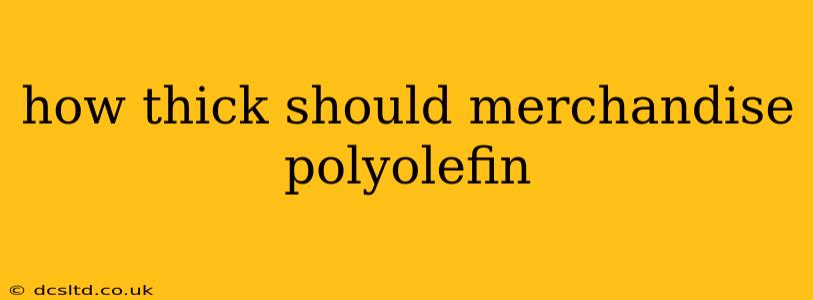How Thick Should Merchandise Polyolefin Bags Be? A Comprehensive Guide
Choosing the right thickness for your merchandise polyolefin bags is crucial for protecting your products and presenting a professional image. The ideal thickness depends on several factors, including the weight and fragility of your items, the intended use, and your budget. This guide will help you navigate these considerations and determine the perfect polyolefin bag thickness for your needs.
Understanding Polyolefin Bag Thickness
Polyolefin bag thickness is typically measured in microns (µm) or mils (thousandths of an inch). One mil equals approximately 25.4 microns. Thicker bags offer greater strength, durability, and puncture resistance. However, thicker bags also increase costs. Finding the right balance is key.
Factors Affecting Polyolefin Bag Thickness Selection:
1. Product Weight and Fragility:
- Lightweight, non-fragile items: For items like t-shirts, lightweight accessories, or stationery, a thinner polyolefin bag (e.g., 20-40 microns or 0.8-1.6 mils) might suffice.
- Heavier, fragile items: Heavier or more fragile items like glassware, electronics, or delicate jewelry require significantly thicker polyolefin bags (e.g., 60-100 microns or 2.4-4 mils or more) to provide adequate protection during shipping and handling.
2. Intended Use:
- Simple product packaging: If the bag is only for point-of-sale presentation and not for shipping, a thinner option might be acceptable.
- Shipping and mailing: For shipping, thicker bags are essential to withstand the rigors of transit and prevent damage. Consider adding extra protection with bubble wrap or other cushioning materials inside the bag.
3. Environmental Considerations:
While thicker bags offer better protection, they also increase plastic consumption. Consider balancing durability with sustainability by opting for a thickness that provides adequate protection without being excessively thick. Explore eco-friendly alternatives like recycled polyolefin or biodegradable options if sustainability is a top priority.
4. Budgetary Constraints:
Thicker polyolefin bags cost more. Balance your budget with the necessary level of protection to determine the most cost-effective thickness for your needs.
Frequently Asked Questions (FAQs):
What is the most common thickness for merchandise polyolefin bags?
The most common thicknesses range from 30-60 microns (1.2-2.4 mils). However, this is just a general guideline, and the ideal thickness will vary depending on the factors discussed above.
Can I use a thinner polyolefin bag if I add extra packaging?
While adding extra packaging like bubble wrap or tissue paper can increase protection, a thinner bag might still not provide enough strength and puncture resistance, especially during shipping. A slightly thicker bag, combined with additional packaging, may provide a better overall solution.
Are thicker polyolefin bags more resistant to tearing?
Yes, thicker polyolefin bags are significantly more resistant to tearing and punctures. The increased material thickness provides greater strength and durability.
How do I choose the right thickness for my specific product?
Carefully consider the weight, fragility, and value of your products, as well as how they will be handled and shipped. You might want to test different thicknesses with a small sample of your products before committing to a large order.
Conclusion:
Determining the correct thickness for your merchandise polyolefin bags requires careful consideration of product characteristics, intended use, environmental impact, and budget. By weighing these factors, you can choose a thickness that balances protection, cost-effectiveness, and sustainability. Remember, choosing the right bag is crucial for protecting your merchandise and enhancing your brand's professional image.
